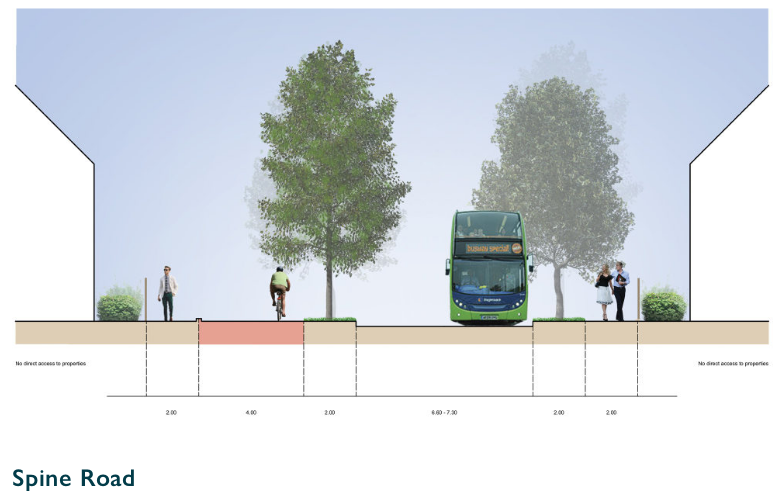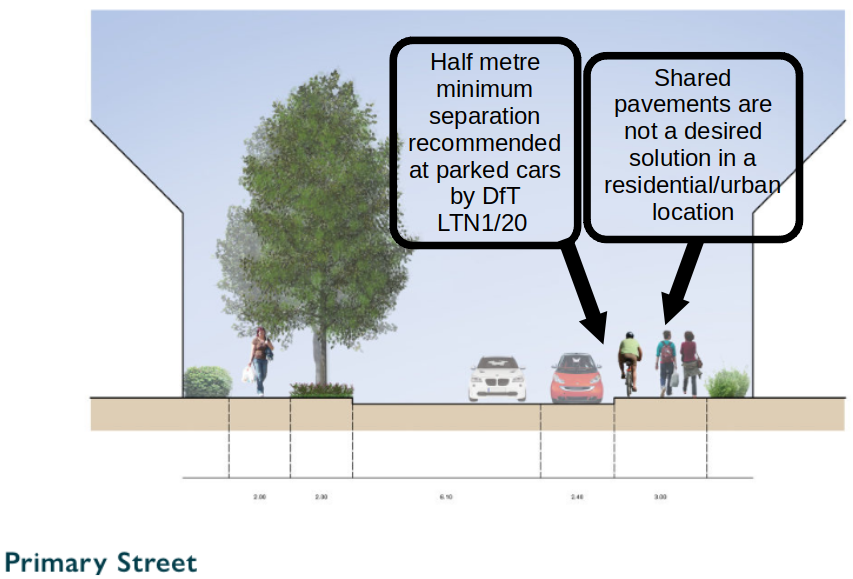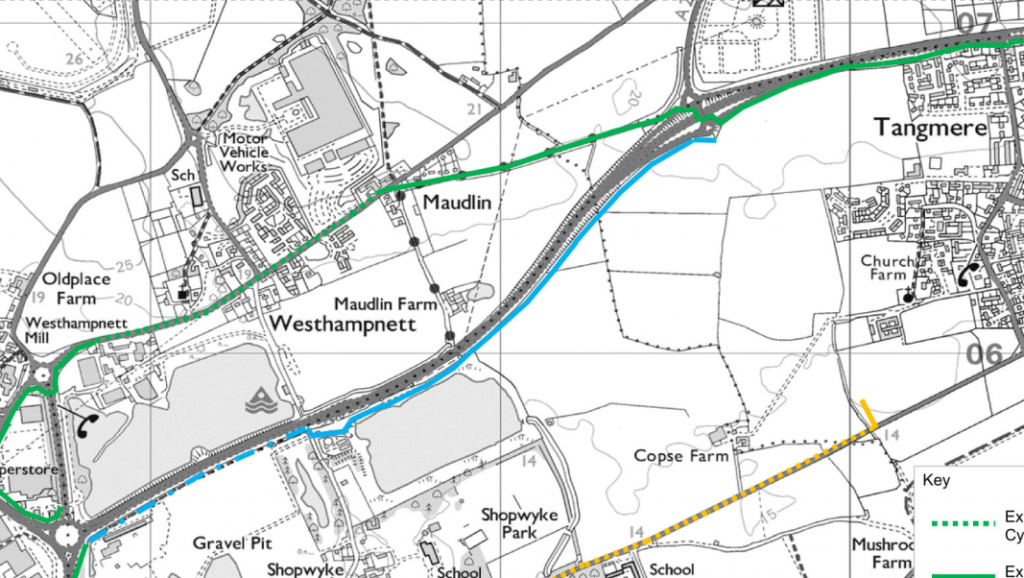Walking and Cycling Provision for the Tangmere Housing Development
Tangmere Housing Development Application 20/02893/OUT incorporates welcome design elements within the development but the absence of a functioning wider area walking and cycling network may leave residents stranded in Tangmere if they do not wish to drive. As with any design, there is room for improvement but there is clear evidence walking and cycling needs within the development are being thoughtfully considered by the architects.
ChiCycle Assessment of Walking and Cycling Infrastructure within the Tangmere Development
- These plans now appear to include a green corridor carrying a kind of separate spine road for cycling on the eastern side of the development. This looks to be separated from the corridor carrying the road-way spine road. Presumably this will be a car free lane within central the heart of the community. This seems likely to allow families to make local journeys to school or to the shops using a route mainly away from the spine road. ChiCycle feel this is a highly desirable design feature. It is extremely welcome because it will facilitate healthy active travel habits in a safe inclusive environment. Moreover, this feature appears to have been included in plans through community engagement with existing Tangmere residents. Details of this cycle route are shown on page 17 of the document DESIGN_AND_ACCESS_STATEMENT_PART_3 . The image below clipped from the document shows the Principal Segregated Cycleway shown in orange.

- The development plan includes a street hierarchy and the document DESIGN_AND_ACCESS_STATEMENT_PART_3 states:
7.37 The Masterplan sets out a permeable and legible network of connections for pedestrians and cyclists. Strategic connections are provided through the site providing connections to the Village Centre and to wider destinations via the Westhampnett cycle path.
The development allows motor-vehicle access to properties by means of quiet streets. Motor-vehicle traffic is filtered by green strips preventing through traffic on most streets. However it appears permeability will be provided for walking and cycling between the parcels of development. ChiCycle feel this is excellent design practice that will encourage local journeys by walking and cycling.
- The spine road snakes around making many journeys by car slightly less direct than walking and cycling trips. This brings the benefit of inherent traffic calming by avoiding a fast straight spine road. Also by zig zaging through the development, the spine road can get motor vehicles close to their destinations leaving only short distances to be completed on the secondary and tertiary streets. This will minimise motor vehicle traffic on the quiet streets. ChiCycle approve of this design strategy.
- Near the southern exit of the spine road the principal cycleway crosses the spine road. It then recrosses it again at the mouth of the spine road exit onto Tangmere Rd. We feel crossing the spine road here twice is undesirable, particularly as it is crossed twice within only a short distance. We feel it would be better to keep the cycle-way on the north east side of the spine road. This might be achieved by relocating the spine road a few metres to the south west so that existing layouts for houses would not need substantial changes made. A sketch of how we recommend the layout is adapted is shown below with the ChiCycle modification shown with a dashed purple-line.

- At the northern end of the development the principal cycleway is shown running adjacent to the spine road. ChiCycle normally oppose this type of solution but in this case it seems unlikely many pedestrians will follow this route out of the development as there is nowhere much that can be reached within a reasonable walking distance. This route is also shown without side-road crossings. Under these circumstances, a relatively short stretch at the north of the development where the cycleway follows the spine road may be an acceptable solution.
- Where the primary cycleway follows the spine road (or indeed anywhere else the cycleway goes) the diagram showing a wide segregated route for cyclists is enthusiastically supported by ChiCycle. An image depicting this layout is shown below.

- We do not approve of the design for primary streets with cyclists sharing pavements. Shared use provision could work in other locations within the development away from the highway, particularly where there is grass or vegetation on either side that pedestrians and/or cyclists can swerve onto if a collision appears imminent. The preliminary designs shows alternative routes away from the roads. We advise on a focus of routes away from the highway being made accessible to cyclists as an alternative to using shared pavements. Of particular concern are the parked cars adjacent to the cycleway. Passengers opening the nearside car door as a cyclist approaches on the pavement will cause nasty accidents. LTN1/20 gives the following advice:
6.5.4 In urban areas, the conversion of a footway to
shared use should be regarded as a last resort. Shared
use facilities are generally not favoured by either
pedestrians or cyclists, particularly when flows are high.
It can create particular difficulties for visually impaired
people. Actual conflict may be rare, but the interactions
between people moving at different speeds can be
perceived to be unsafe and inaccessible, particularly by
vulnerable pedestrians. This adversely affects the
comfort of both types of user, as well as directness
for the cyclist.6.2.42 Kerbed island separation or light segregation
(see Figure 6.15) that provides a buffer zone of at least
0.5m between cyclists and parked vehicles is
recommended to minimise risk of collision between
cyclists and vehicle doors. A clear, level width of 2.0m is
required alongside disabled parking bays to allow users
to unload a wheelchair and turn within the space.The following image details our concerns.

The ChiCycle position is that it would be better to make the pavements 2.5 metres wide on both sides for the benefit of pedestrians, not to included shared use pavements and focus on high quality provision for cycling elsewhere. - High levels of inherent traffic calming on secondary and tertiary streets create environments suitable for all members of the community to walk or cycle. ChiCycle support designs for quiet streets that are safe to be shared by all road users.
ChiCycle Assessment of Wider area Cycle Routes with the Tangmere Development
- It is commendable that the developers have discussed these matter with local community groups such as the Chichester District Cycle Forum. Assessment details can be found on pages 14 and 15 of the document 20_02893_OUT-TRANSPORT_ASSESSMENT_-_PART_2-3067405
- ChiCycle do not favour the Westhampnett Route because the shared pavement scheme there is not safe, convenient or appealing to cyclists and the route from Westhampnett to the centre of Chichester is only suitable for brave/foolhardy cyclists.
- ChiCycle strongly recommend perusing opportunities for a cycle route running just south of the A27 that has been referred to as the Shopwhyke Lakes Route shown in blue in the diagram below.

Unfortunately the Shopwhyke housing development is going forwards with few realistic provisions for walking and cycling. However this route still appears to remain by far the most inclusive opportunity for people to access Chichester from Tangmere by bicycle while avoiding hostile heavy traffic on the alternative Tangmere or Westhampnett routes
Missed Opportunities
What this scheme particularly highlights is the failure of the Section 106 of the Town and Country Planning Act 1990 to cater for community transport needs. Local authorities have produced a local plan but this contains no specific schemes for new rail, public transport, walking, or cycling solutions. However, it is acknowledges that these are solutions that could provide desirable alternatives to motor car dependency. Without a coherent plan available in advance for how wider networks supporting sustainable travel could be routed, S106 is wasted on inappropriate shared use pavement schemes that are unappealing to both pedestrians or cyclists alike.
The Chichester Local Plan Review 2016-2035 Preferred Approach states:
5.27 In addition, the County Council is expected to continue to support new development through a package of transport improvements which will continue to aim to reduce congestion and encourage people to use sustainable modes of travel such as walking, cycling and public transport. The District Council will shortly commence work on updating its local Cycling, Walking and Infrastructure Plan to help prioritise projects for delivery, particularly in Chichester City Centre. A key objective is to achieve a significant shift in travel behaviour aimed particularly at reducing car use for short distance journeys. Proposed measures are likely to include continuing to target investment in local transport infrastructure, focusing on delivery of improved and better integrated bus and train services, and improved pedestrian and cycling networks…
To the East of Chichester there a great many new housing developments including, Grailingwell, Maudlin-Westhampnett, Madwick-Park and Shopwhye. While these projects were in their planning stages DfT guidelines LTN1/12 strongly advised against running two way cycle traffic on urban pavements, particularly where there are frequent side roads and driveways. However these guidelines were sadly ignored and the S106 contributions were squandered on inappropriate solutions will do little to encourage walking and cycling.
Worse still, these new developments are isolated from walking and cycling opportunities reaching into the City centre. Although it is possible for pedestrians to walk to the city, the heavy traffic of the A285 makes the environment extremely unpleasant. The A285 route into the city could no way be considered a convenient inclusive environment for family cycling.
As Chichester is becoming a broadening East West string of communities, forward thinking opportunities for tram, light-rail and trolleybus have been ignored. Consequently, opportunities for moving to efficient low carbon forms of public transport will be severely hindered in the future.
ChiCycle feel local authorities urgently need to refocus resources away from road improvements that will cement a culture of car dependency and instead implement high quality infrastructure dedicated to sustainable modes of transport. Significant investment is required to realistically tackle the dual challenges we face with local gridlock and global climate-change.
We have communicated our position to CDC planning sending this PDF copy of the details included in this post.